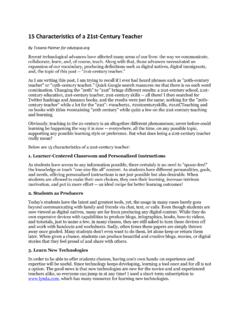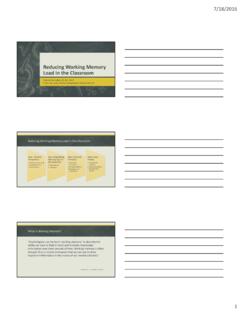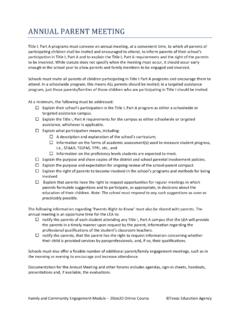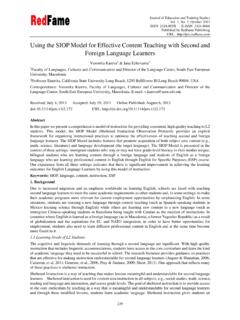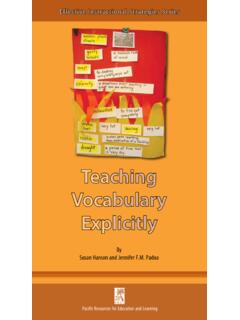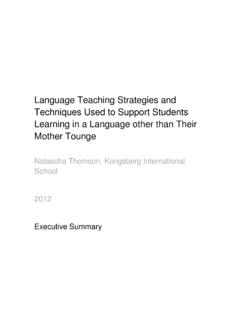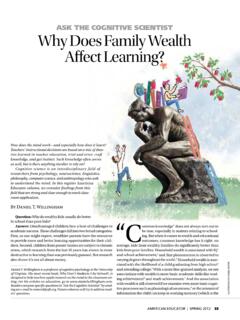Transcription of Making Content Comprehensible for Interaction: English ...
1 Making Content Comprehensible for 5. Interaction: English Language Learners SIOP Model Provide frequent opportunities for SHELTERED INSTRUCTION interaction and discussion Supplies much needed oral rehearsal . for Academic Achievement Group students to support language and Content objectives use at least 2 different Key Components Teaching language and structures during a lesson pairs, triads, teams, varied by Content effectively: language proficiency or interest Consistently afford sufficient wait time . 1. Preparation: let other students write down answers while waiting for one student to respond Clearly define Content objectives Give ample opportunities for clarification Write on the board State orally for concepts in L1 use bilingual Clearly define language objectives paraprofessionals, native language materials, notes by students.
2 Write on the board State orally Choose Content concepts for age 6. Practice/Application: appropriateness and fit with Supply lots of hands-on materials educational background of students Provide activities for students to apply Use supplementary materials to make Content /language knowledge discussing lessons clear and meaningful and doing make abstract concepts concrete; allow students Adapt Content to all levels of student to work in partners before working alone proficiency use graphic organizers, study Integrate all language skills into each guides, taped texts, jigsaw reading lesson--listening, speaking, reading, writing Provide meaningful and authentic activities that integrate lesson 7. Lesson Delivery: concepts with language practice Clearly support Content objectives.
3 Opportunities surveys, letter writing, Making objectives apparent throughout lesson; no bird-walks . models, plays, games Clearly support language objectives . students given ample opportunities to show off their language capabilities in speaking, reading, writing 2. Building Background: Engage students 90-100% of the Explicitly link concepts to students' lesson less teacher talk , no down-time , students background experience are actively working in whole groups, small groups, Make clear links between students' past individually . learning and new concepts Appropriately pace the lesson to Emphasize key vocabulary students' ability level 8. Review/Assessment: 3. Comprehensible Input: Provide comprehensive review of key Speak appropriately to accommodate vocabulary teach, review, assess, teach ; use students' proficiency level word study books, Content Word Wall.
4 Clearly explain academic tasks Supply comprehensive review of key Use a variety of techniques to make Content concepts review Content directly related Content concepts clear--modeling, hands-on to objectives throughout lesson; use graphic organizers as materials, visuals, demos, gestures, film clips review Regularly give feedback to students on 4. Strategies: their output--clarify, discuss, correct responses Provide ample opportunities for students Conduct assessment of student to use strategies--GIST, SQP2R, Reciprocal comprehension and learning use a variety Teaching, mnemonics, 12 minute research paper, 2 column of quick reviews: thumbs up-down, numbered wheels, small notes, repeated readings, dry erase boards; include student self-assessment.
5 Consistently use scaffolding techniques Source taken from: Making Content Comprehensible for English Language Learners , Echevarria, Vogt, Short throughout lesson --think-alouds, paraphrasing, partnering Compiled by the Bilingual and Compensatory Education Resource Team, Employ a variety of question types use Dearborn Public Schools, Michigan 2002. Question Cube, Thinking Cube, Bloom's Taxonomy . Jigsaw text reading: Making Content Comprehensible One or two members of each cooperative team are 1. Lesson Preparation chosen by the teacher to form an expert team. Each expert team is responsible for one section of assigned text. Text sections are read aloud in the expert team , Adaptation of Content : discussed and reviewed for essential information, key Make texts accessible to all students without watering down vocabulary , and better collective understanding.
6 When texts clear understanding is reached, expert team members return to their original cooperative teams to teach their Use before, during, and after reading or writing teammates demonstrating peer-modeling. English Language Learners benefit from this system because they Graphic Organizers: are learning from others while not burdened with reading Schematic visuals that assist students to grasp the the longer text. wholeness and parts of a concept. Use to supplement written or spoken words-- Leveled study guides: --Before reading or writing: guides and supplements to build Teacher composes guides to accompany students'. background for difficult or dense text and helps organize writing textbook may include: --During reading: focuses students' attention and makes connections, Summary of text Questions-- Statements of learning helps with taking notes and understanding text structure --After reading or writing: assists in recording personal understandings Teacher can designate questions for different levels by and responses; double-checks organization marking with * (easiest), ** (moderately challenging, and Examples: I Wonder , Venn Diagrams Timelines, ** (most challenging).)
7 Discussion webs, Thinking maps . Tip: With English Language Learners, it is helpful to actually construct the graphic organizer in front of the students on chart paper or Supplementary Materials: Sources transparency for deep understanding Hands-on manipulatives and realia connects abstract concepts Outlines: with concrete experiences and student's own life Teacher prepared outlines that help students take notes in Pictures, Photos, Visuals: provide visual support to harder an organized manner concepts. Helps relate to prior knowledge and oral presentations. Tip: T-charts are useful outlines to begin organizing Include models, charts, overheads, maps, timelines as you are Tip: Some students need picture support, or to see the completed presenting concepts outline first Multimedia: film clips, songs and chants, posters, computer games, to concept solidify key concepts into the Highlighted text: deep memory For newcomers: highlight (using blue highlighter) key Demonstrations: Model step-by-step completion of tasks, or concepts, important vocabulary , and summary model language to use with presentations.
8 This scaffolds and statements in students' textbooks. Newcomers only read enhances learning highlighted sections. This reduces stress yet maintains Related Material: Most Dearborn schools have a multitude of key concepts. leveled books both fiction and non-fiction that supplement science and social studies themes. Check your school's resource room for materials. Marginal notes: Source taken from: Making Content Comprehensible for English Language Like highlighted text, teacher notes in the margins of a Learners , Echevarria, Vogt, Short newcomer's textbook assist in focusing attention on important ideas, key concepts, key words and their Compiled by the Bilingual and Compensatory Education Resource Team, definitions, or draw attention to important supporting facts Dearborn Public Schools, 2002.
9 For why or how . The Teacher's Edition marginal notes may help in choosing key facts, etc. Parent volunteers could assist in putting in marginal notes in multiple textbooks. If you didn't want to write in actual student textbooks, you could use sticky notes that are removable. Taped Text: Teacher, paraprofessional, or older student tapes textbook for newcomers. This allows for multiple exposures to text and should improve reading and understanding. Students can take home text and tape for homework. Adapted Text: Sometimes it is necessary to rewrite dense text in order for English Language Learners to comprehend a Content . Short, simpler sentences are easier for newcomers to understand. The format should follow a topic sentence followed by several supporting detail sentences.
10 All sentences need to be relevant to the Content . Maintaining a consistent format affords easier reading and more connections to prior knowledge. 5. Concept Definition Map A simple graphic system used to discuss complex Making Content Comprehensible concepts and clarify the meaning of a concept. 2. Building Background Ex: Concept Definition Map Revolution What is it? What is it like? There is a strong correlation between vocabulary knowledge and Overthrow of Government student achievement Can be violent Select fewer key terms to focus on Explicitly teach school language ex. Identify, compare, Often emotional summarize, define . Usually political 1. Contextualizing Key vocabulary : Revolutio Review the Content and select key terms that are critical to understanding the lesson's most important concepts.
